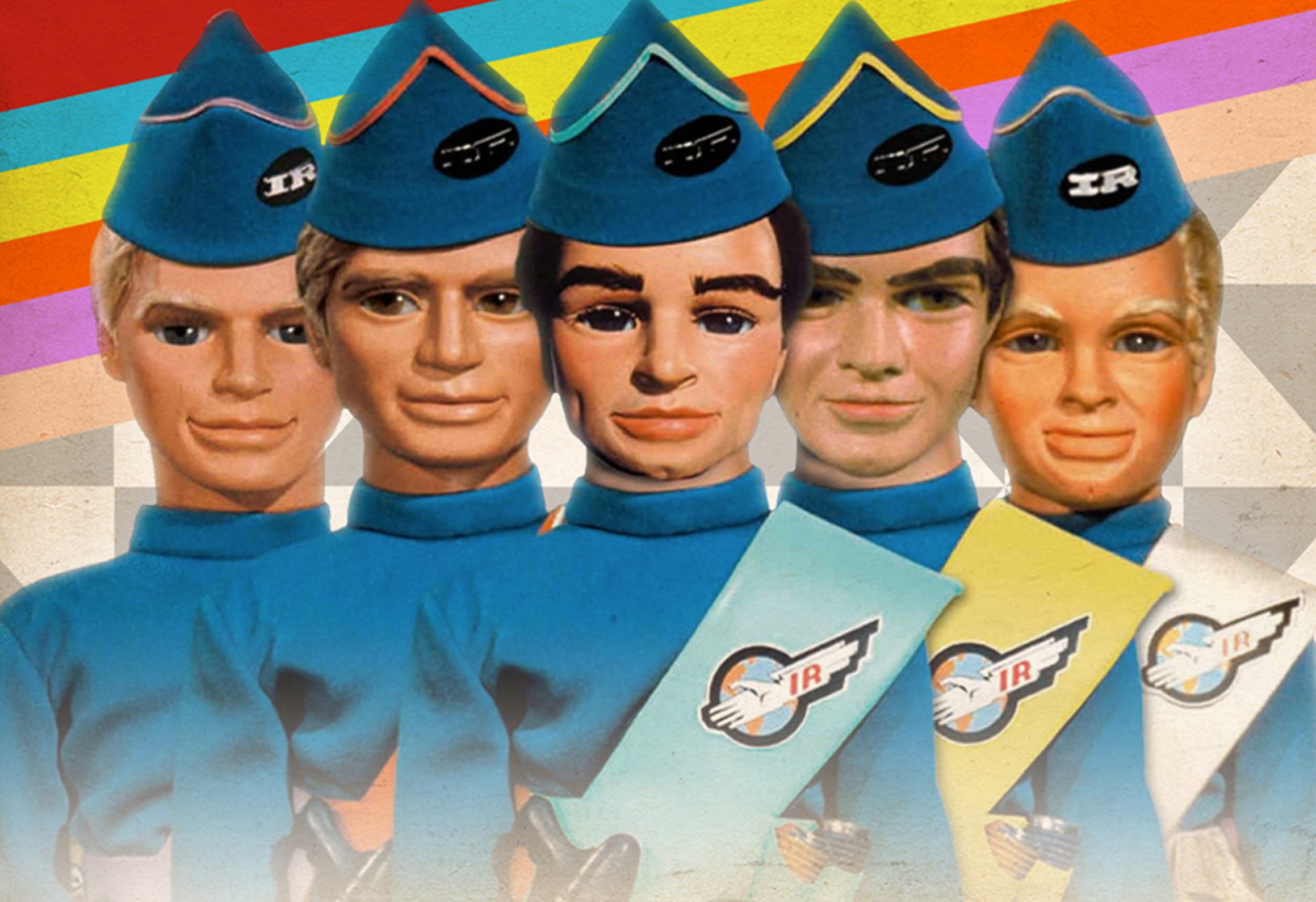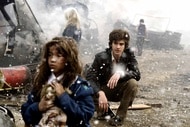Create a free profile to get unlimited access to exclusive videos, sweepstakes, and more!
Remembering the Innovation and Imagination of Sci-Fi Puppet Show Thunderbirds
When you've seen a Gerry Anderson puppet, you know it.

On October 24, 1963, a sedimentation pond near Salzgitter, Germany dumped half a million cubic meters of murky water into the Lengede-Broistedt iron mine. Seventy-nine of the mine’s 129 workers escaped over the next few hours, but the remaining 50 were trapped. Over the next two weeks, rescuers attempted to make contact with and rescue any survivors with little success. Eventually, rescuers drilled a hole 52.2 centimeters (20.6 inches) wide and pulled 11 miners up 59 meters (194 feet) of freshly drilled mineshaft inside a torpedo-shaped retrieval capsule called the Dahlbusch bomb.
The painfully slow rescue effort wedged itself in the mind of Gerry Anderson and remained there until a few weeks later when he arrived at a meeting about his next creative endeavor. Anderson was one half of the creative team (the other half being his wife Sylvia) behind a number of television shows starring marionettes which aired on British television during the middle of the 20th Century. As Anderson arrived at the meeting to pitch his next show, he couldn’t stop thinking about how there should be an international organization with the tools and the knowhow to jump into action when they are needed.
Because no such organization existed, Anderson set out to invent one and put it on TV. Anderson pitched the show with the straightforward working title International Rescue, but by the time the first episode hit British television sets in 1965 it had been rechristened Thunderbirds.
Thunderbirds Imagined a Kinder Future with International Rescue
Far from the simple puppet shows you may be imagining, the Andersons pioneered an artform they called supermarionation (a mashup of the words “super,” “marionette,” and “animation”) which elevated the medium and made filming for television a little bit easier. Their process relied on specially built hybrid marionettes with manually manipulated bodies but electrically controlled mouths.
During production, the voice cast entered a studio and recorded their lines. Two copies of each recording were made, but only one of them was used for the actual audio heard by viewers at home. The other track was converted to pulses which were sent to the puppets during filming to automatically coordinate their mouth movements with the pre-recorded audio track, leaving the performers free to focus on motion.
Puppets, sets, and props were built at scale, and despite the limitations (the puppets couldn’t walk convincingly so moving shots were mostly shot above the waist, for instance), the creative team managed to achieve an immersive and convincing fictional world. Thunderbirds succeeded in a way the Andersons’ previous shows hadn't (it earned itself two film sequels and a live action adaptation directed by Commander Riker himself, Jonathan Frakes) by appealing to a wider audience including kids and adults. It brought the kids in by virtue of its medium – watching Thunderbirds is like seeing your action figures come to life – and grabbed hold of their parents with drama and stakes on par with contemporaneous live action adult-oriented content. Thunderbirds may have been a show starring puppets, but it was also an hour-long sci-fi drama and it never sacrificed one identity for the other.
The Near-Future of Thunderbirds Has the Same Old Drama but Cooler Tech
The series ran for 32 episodes over two seasons, all of which is streaming on Peacock right now, by the way. At the time, the narrative was set a century in the future, taking place between an imagined 2065 and 2067. Today, it doesn't feel so far off.
Our heroes are the brave members of International Rescue, a group of heroes who embody the skills and values Anderson imagined would be valuable in a moment of disaster. The secret organization is led by retired astronaut Jeff Tracy, who commands his five adult sons on a series of elite, covert missions. Each son – Scott, Virgil, Alan, Gordon, and John – is named for one of the real-world astronauts of Project Mercury, the first Americans to go to space: Scott Carpenter, Virgil "Gus" Grissom, Alan Shepard, Gordon "Gordo" Cooper, and John Glenn, respectively.
Each of the Tracy boys are also identified by one of five Thunderbirds, an advanced mechanical wonder for which the series derives its name. These machines, dubbed Thunderbird 1 through Thunderbird 5, form the foundation of International Rescue’s incredible abilities. They are, in ascending order, a hypersonic rapid response rocket plane, a supersonic carrier aircraft used to cart equipment from one disaster to another, a single-stage orbital spacecraft, a small yellow submarine, and a geostationary space station. Meanwhile, Thunderbird 2 (the carrier) housed a wide range of other gadgets in deployable pods including the Demolition and Object Moving Operator (DOMO), a drill-faced tunneling machine called the Mole, and a vehicle sporting an EMP generator capable of knocking out nearby electronic and communications equipment called the Neutralizer Tractor.
Most of the action followed Jeff Tracy and his five adrenaline-seeking sons as they battled various nerdowells. Every now and again you’d also see an appearance from a supporting character including Grandma Tracy (Jeff’s mom), Brains (the engineer and tinkerer who built the Thunderbirds), Tin Tin and her father Kyrano (the family’s domestic servant), and Lady Penelope (member of British high society, supermodel, fashionista, and field operative for International Rescue). As for the forces of evil, dastardly duties typically fell to the Hood, a recurring villain who can control people using hypnosis and telepathy and happens to be Kyrano’s half-brother. Hood wants, more than anything, to get hold of International Rescue’s impressive technology and sell it to the highest bidder.
Thunderbirds Envisioned the Future Through the Fog of the Past
Sylvia and Gerry Anderson crafted their story with an eye toward the ideal future. From the jump, it was built on imagining the world not as it is or was, but as it could be. The underlying premise, that people should receive help when they need it regardless of where they’re from or what resources they have available, is an objectively good one. But that doesn’t mean the show is perfect; it certainly has its flaws.
Despite facing toward the future, it’s impossible for Thunderbirds to escape the fingerprint of the time and environment in which it was made. Villains can often be identified by the color of their skin (although there are some positive representations of non-white characters) and all of the key characters are men. Even in the wider cast, there are only three substantial characters (Grandma Tracy, Tin Tin, and Lady Penelope) who are women. How easy it would have been for the Andersons to make a few or even one of the Tracy children non-men.
RELATED: How the new Dark Crystal used modern tech on Henson's old-school puppetry
There are also frequent depictions of characters smoking, something which was common in the ‘60s when the show was made, less common today, and likely to be even less common in another 40 years. A 2002 study analyzing the frequency and type of smoking in the series and the potential impact of popular culture on public health attitudes found that smoking occurred in 26 of 32 episodes, sometimes multiple times an episode. Rather than reinforcing the Andersons’ visions of the future, these elements cement Thunderbirds as a product of the past.
The Ongoing Legacy of Thunderbirds
Even if you’ve never seen an episode of Thunderbirds (something you can fix on Peacock, we remind you), it’s likely to be immediately recognizable as the progenitor of Matt Stone and Trey Parker’s Team America World Police.
The stories have a similar premise (though wildly different tones) in a team of people endeavoring to protect the most vulnerable and imperiled people on Earth. And the similarities also rise to the surface with a certain family resemblance between the Andersons’ puppets of yesteryear and the slightly more modern Team America character designs. In an interview during the production of the flick, the South Park creators stated unequivocally that Thunderbirds was “definitely what inspired the look of this film.”
That’s not all they had to say. The experience of making Team America was so unpleasant that Stone and Parker suspected Anderson must have been wired differently to do it more than once. “How you could do this and do it again, I do not understand. He did it for years and years and years — and I don’t understand how,” Parker said, and Stone added, “But honestly, I don’t know what the hell’s wrong with that guy.”
Perhaps the most important long-term consequence of Thunderbirds is in being a fictional seed which has borne real-world fruit. In 1981, responding to the then still lingering consequences of the Irpinia earthquake the previous year, volunteers formed the International Rescue Corps. Named for the fictional International Rescue and helmed in part by Gerry’s son Jamie Anderson, the International Rescue Corps aims to realize the futuristic ideals of International Rescue in the present.
If there are any clues, you’ll find them in Thunderbirds, streaming now on Peacock.





























